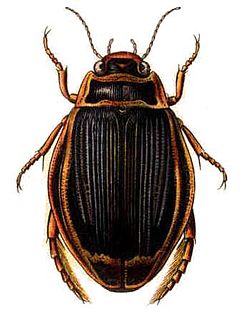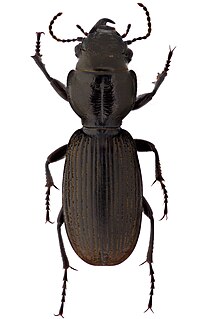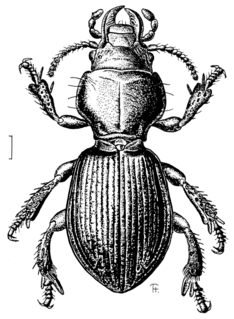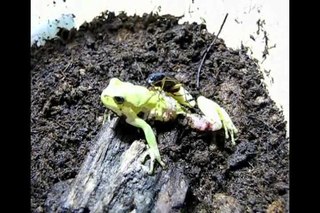
Ground beetles are a large, cosmopolitan family of beetles, the Carabidae, with more than 40,000 species worldwide, around 2,000 of which are found in North America and 2,700 in Europe. As of 2015, it is one of the 10 most speciose animal families.

The Adephaga, with more than 40,000 recorded species in 10 families, are a suborder of highly specialized beetles and the second-largest suborder of the order Coleoptera. Members of this suborder are adephagans, a term which notably include ground beetles, tiger beetles, predacious diving beetles, and whirligig beetles. The majority of the species belongs to the family of carabids, or ground beetles (Carabidae).

Mecodema oconnori is a large-bodied species of ground beetle endemic to the lower half of the North Island, New Zealand. It is mainly found in native forest habitats on the western side of the Tararua and Ruahine Ranges, but is also found in the Manawatu Gorge and some other eastern localities.

Ant nest beetles or paussines, some members of which are known also as flanged bombardier beetles, are a large subfamily within the ground beetles (Carabidae). The tribes Metriini, Ozaenini, Paussini and Protopaussini are included in the subfamily.
Agra katewinsletae is a species of carabid beetle named after English actress Kate Winslet.
Agra liv is a species of carabid beetle named after the "first name of the actress Liv Tyler, starlet of the movie, Armageddon...because the "existence of this species of elegant beetle is dependent upon the rainforest not undergoing an armageddon."

Broscus cephalotes is a species of nocturnal, coastal ground beetle found throughout most of Europe. Its range spans from western Europe into western Siberia. The species was introduced recently in the eastern areas of Canada and has spread farther south and west into the United States. As a member of the family Carabidae, Broscus cephalotes is generally considered beneficial to humans due to its predatory habits. Their varied diet often includes crop pests and other small organisms.

Brullea antarctica is a carnivorous carabid beetle, the only species in its genus, that burrows in sand above the high tide mark on New Zealand beaches. Both the genus and species were first described by Francis de Laporte de Castelnau in 1867.

Oregus is a genus of beetles in the family Carabidae that is endemic to New Zealand. A 2003 taxonomic revision of the group using both morphological and DNA characters concluded that it contained four species, and identified new species from Marlborough and North Canterbury. The current species list is:

Maoripamborus fairburni is a species of beetles in the family Carabidae, the only described species in the genus, though there are some reports of an additional undescribed species. The genus is endemic to northern North Island in New Zealand, and is most closely related to the Australian genus Pamborus.

Graphipterus is a genus of beetles in the family Carabidae, containing the following 139 species:

Epomis is a genus of ground beetles (Carabidae). The larvae of this genus are notable for being obligate role reversal predators. Amphibians such as frogs are normally predators of beetles, however Epomis larvae feed exclusively on amphibians.

Epomis circumscriptus is a species of ground beetle native to the Palearctic, the Near East, and North Africa.

Anthia venator is a beetle of the Family Carabidae.

Siagona jenissoni is a species of beetles in the family Carabidae.

Ross Taylor Bell was an American entomologist with particular interest in the invertebrate natural history of Vermont, United States, and carabid beetles. Together with his wife, Joyce Bell, his work at the University of Vermont was largely taxonomic, where they described more than 75% of the rhysodine species known to science. Ross also wrote a number of seminal papers in his chosen field.
Rhadine caudata is a species of beetle native to the eastern United States. It is a brachypterous habitat specialist, occurring in only two of five forest classes in a North Carolina study. R. caudata is a considered a Vulnerable species at the global level on NatureServe, Imperiled in Alabama, and Vulnerable in Virginia.
Carl Hildebrand Lindroth was a Swedish entomologist and a professor at Lund University. He was a specialist in carabidology, with a special interest in biogeography. He was a strong proponent of the glacial refugium hypothesis and made use of the framework to explain the distribution patterns of Scandinavian beetles.

Mecodema howitti, termed the Large Banks Peninsula ground beetle, is a carnivorous forest ground beetle in the genus Mecodema. It is endemic to Banks Peninsula, Canterbury, New Zealand, and is the largest of the 16 carabids found in the area.















